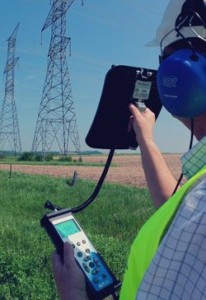Understanding the various applications of ultrasound
 When a maintenance person hears the word ultrasound, they immediately think of air leaks. While ultrasound is good at finding leaks involving compressed gases (air, steam, nitrogen, CO2, etc.), it can do much more. If you look at a typical P-F curve, you will that ultrasound enables organizations to find defects further up the curve, even more so than vibration analysis. How many maintenance staff knows that? Combine the ease of use, cost effective and the early detection ability of ultrasound and any organization has a winning combination to improve their uptime.
When a maintenance person hears the word ultrasound, they immediately think of air leaks. While ultrasound is good at finding leaks involving compressed gases (air, steam, nitrogen, CO2, etc.), it can do much more. If you look at a typical P-F curve, you will that ultrasound enables organizations to find defects further up the curve, even more so than vibration analysis. How many maintenance staff knows that? Combine the ease of use, cost effective and the early detection ability of ultrasound and any organization has a winning combination to improve their uptime.
To reap the full benefits of using ultrasound in condition monitoring, it is important to understand all of the potential applications for it.
Ultrasound can be used in;
- Airborne applications
- Flow monitoring
- Electrical applications
- Tightness testing
- Friction
- Impacts
- Linear motion
In addition to the applications listed above, there are new applications being regularly discovered. The imagination and ingenuity of the users provide the community with these new uses. But for now, let’s focus primarily on the applications list above.
Airborne Applications
Airborne applications are what typically comes to mind when thinking of ultrasound. It is compressed gas leaks. While a technician may be able to hear some air leaks, the chances are that there is a tremendous amount of air leaks that cannot be heard during normal operation of a plant. Also, vacuum leaks can be detected as well, but are usually a bit more difficult to detect. This is where the acoustic horn and quality training come into play.
Mechanical issues can also be detected with ultrasound using airborne sensors. For example, you can inspect belts using ultrasound and listen to see if the belt is slapping (the belt is loose). Also, belts can be checked for over tightness by listening for excess friction. Couplings can be monitored the same way, by listening for friction. Bearings can be monitored for certain defects such as lack of lubrication (friction) and for certain mechanical defects that produce an impacting sound. Lastly, chains can also be monitored with ultrasound, listening for the repeating process of the chain slipping over the tooth.
Flow Monitoring
Flow monitoring is addressing one of the most prevalent industrial process, the transportation of fluids and gases. Ultrasound can be used within these types of processes to monitor the condition of not only the system but specific components within it. Steam traps can be monitored to see if they are operating correctly, opening, closing and not leaking.
Valves can also be monitored to see if they are opening, closing and sealing properly, by listening for turbulence and cavitation. Flanges can also be monitoring for leaks, by listening for turbulence.
Electrical Applications
Electrical applications are another area where maintenance staff may be more familiar with ultrasound as it is usually done in conjunction with Thermal Imaging. But what specifically can ultrasound be used for in electrical applications? Particle discharge is a major application for an ultrasound. Particle discharge occurs when;
- Internal discharge in voids and cavities
- Surface discharge along different materials
- Discharges on stressed electrodes in the air
- Sparking to components
In addition to particle discharge, ultrasound can be used to monitor electrical systems for corona (the ionization of the air around high voltage conductors), tracking, and arcing. Lastly, ultrasound can be used to listen to the internal component of an electrical panel before opening the panel door.
Tightness Testing
Tightness testing using ultrasound is a great way to ensure vessels are closed and sealed properly. Not every vessel can be vacuum testing or pressure tested, and this is where ultrasound comes in. By using an ultrasonic transmitter (placed in the vessel), and closing/sealing the vessel, an ultrasound tool can be used to detect leaks or gaps in the seals. This application is great for checking seals of tanks and ocean (or the Great Lakes) going vessels. The same technique can be used to check buildings for potential air intrusion and energy loss. Lastly, a slight variation of this technique can be used to check the condition of heat exchanges.
Friction
Friction is a common enemy of machine reliability. Friction can be found in many different places but is commonly found and thought of in bearings. This is one of the reasons why organizations perform lubrication tasks. By monitoring the friction in bearings using ultrasound, proper and accurate lubrication can be performed. This is known as Acoustic Lubrication. Acoustic Lubrication is a large topic and will be covered further in another post.
Impacts
Impact monitoring can be considered similar to vibration analysis. The bearings and other rotating equipment are monitored for repeating impacts and the severity of the impacts. There is a detailed analysis of this activity, and the technique will not be covered here.
Linear Motion
Linear motion is used extensively in industry and can be found in hydraulic & pneumatic systems, as well as linear bearing, spur gear & rails and ball screws. The monitoring of the hydraulic and pneumatic systems is focused on leaks and internal bypassing of the cylinders.
The linear bearings and other mechanical systems can be monitored for impacts and friction using airborne sensors and occasionally contact sensors.
As you can see, ultrasound has a lot of different applications in which it can be used. Combine this with the low cost and ease of use; it is easy to see why ultrasound should be part of any condition monitoring program. Many of the modern ultrasound tools have software available to track, trend and analyze the results in a scientific way as well.
How many of the reader have an ultrasound as part of their condition monitoring program? How effective is the program? For those that don’t SDT Ultrasound offers the tools, equipment, and training to enable any organization to successfully implement ultrasound condition monitoring. If you are interested in any SDT offerings, please contact [email protected].
Remember, to find success; you must first solve the problem, then achieve the implementation of the solution, and finally sustain winning results.
I’m James Kovacevic
Eruditio, LLC
Where Education Meets Application
Follow @EruditioLLC
References;


Nice informative article, really the usage of the ultrasound was awesome we can use Friction, Linear Motion applications also, want to Manage the Energy sources in right way go for OpenDEM , its a Distributed Energy Management Software used to Monitoring, Managing the Energy Sources from any place, its also predicts the future usage of the Energy and many more feature check out the website for more details, thank you.